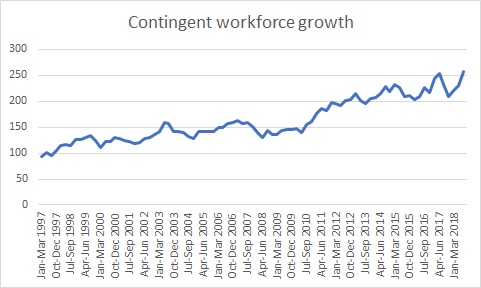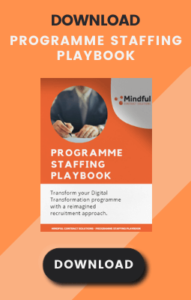It is widely accepted that contingent labour offers a rich source of capability and experience, and is a growing pool. However, many organisations continue to bet small with tactical engagement of contingent workers. At Mindful, we think this is a trend you can bet big on. Here’s why and how.
The numbers
It is clear from statistics from the ONS that contingent labour workforce has almost doubled in the last decade. However, the approach to hiring and contracting contingent labour has not caught up. The industry is still role driven and sourced via job boards.
By way of example, JobServe (a leading recruitment website) has around 3,750 contract jobs listed on it in the last 7 days. The recruitment process mirrors that employed for employees, albeit for contract workforce the selection processes can be somewhat light weight.
Our take on Contingent Labour
The evidence points to a changing trend in employment preferences. There is clearly a large pool of people wanting to be engaged as a business. They are also willing to accept the financial and contractual risks that come with this approach to generating an income. However, in the eyes of employers / engagers, contingent labour is an expensive option to hiring employees.
This has led to contingent labour still considered as a last resort option to filling roles within the organisation. At Mindful, we regard contingent labour pool not in competition with employees for roles, but instead with suppliers providing managed services. Used intelligently with the right contracts in place – a group of resources from the contingent labour workforce can be a formidable alternative to hiring an IBM!
In our blog article, High Volume Recruitment for Digital Programmes – How to Get it Right, we explore 4 tips for getting high volume recruitment right.
How you can bet big on the trend?
There are three things you can do to make your organisation ready to capitalise on the trend of increased self-employment.
- Contingent labour recruitment should shift from an HR responsibility to Procurement
Put simply, if labour remains with HR for management, the comparator will always remain employees. If it shifts to Procurement, the comparator will shift to systems integration suppliers. When compared against systems integration suppliers, contingent labour will feel like a cheaper and more assuring alternative, and will fulfil a more strategic supply side function rather than merely a role or two in your in-house team.
2. Hiring teams instead of individual roles
Recruitment agencies and employment intermediaries should be used more than just tactically. The current brief-driven approach to contractor hiring is inadequate for the purposes of betting big. You need an intermediary who can help define the service and identify resources from the contract market (and substitutes over time) – who are not only great but also can work well together. In essence, your intermediary needs to step up to be a service integrator.
3. Contracting for outcomes
When it comes to contracting, the contingent labour workforce is an extremely flexible lot. The resources are accustomed to signing boilerplate contracts with different agencies over their contracting careers. There lies the opportunity to draft your ideal outcome driven contract you may have unsuccessfully attempted in the past with the big IT systems integrators.


